I don’t regret just getting on with those gardens, because as we know, gardens are ever changing, one of many reasons why gardening never gets boring. I’ve made no secret of the fact that some of the first gardens I created were not really designed at all, but had random plants plunked in them. Now, as I revisit those areas, I’m taking a much more conscious and measured approach in my plan. My color and plant palette is more restrained (although still probably not restrained enough) and I give much more thought to plants selection.
Last fall I cleaned out a large section of what I call the patio garden, the most prominent garden we have. For years, much of that part was filled with rudbeckia and anemones that were allowed to spread out. Both are excellent plants that I wouldn’t be without, but I struggled to make them work in that location and constantly struggled with plant combinations. I incorporated a fair amount of compost and leaf mold to refresh the soil there so a blank slate will await me in spring.
It looks like a complete mess in this photo that I took in fall, with overgrown annuals surrounding it. But I have a vision of a more refined space.
Although I’ve not worked up a complete planting plan for the area, I’ve selected three plants that will make up a bulk of the planting there (and that I’ll repeat farther east in that garden).
 |
| Fall color: White Flower Farm photo |
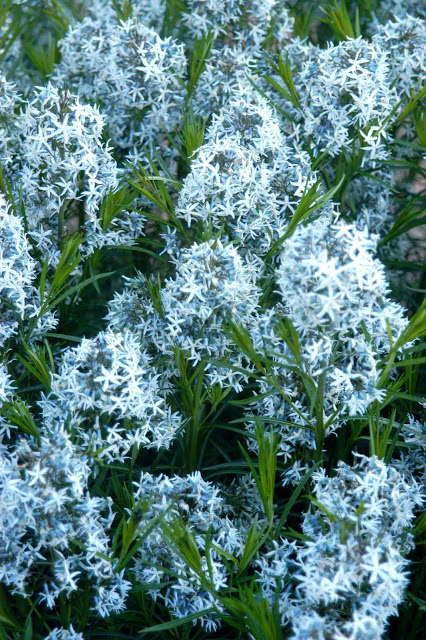 |
| In flower: Grimms Gardens photo |
The first is Amsonia hubrictii. This is not a new plant. In fact it was the perennial plant of the year in 2011, but for whatever reason I didn’t take note of it then. Then last year, I kept running into it at various gardens and couldn’t get it off my mind. It’s the foliage that I love. Wispy, threadlike leaves create a cloudlike texture that I love. And it turns a brilliant yellow in fall, which will provide some much-needed color in that part of the garden.
Side note: The Chicago Botanic Garden did a plant evaluation of hardy amsonias. These are amazing resources so I always look for them when deciding what to plant.
The second plant is Calamintha nepeta ‘Montrose White’. Again, it’s not a new plant, but was one I wasn’t familiar with until last year when I attended a talk by designer Carrie Hennessy from Johnson’s Nursery. It was named by Mike Yanny (who is responsible for developing some amazing trees and shrubs), whose wife got it from Montrose Nursery and saw how it thrived. It’s deer resistant, doesn’t flop, gets no more than 18 inches tall, and is said to bloom from June through frost. It’s also sterile and is said to root incredibly easy from cuttings. What more can you ask for in a perennial? I’ve said it before and it still holds true: The bones of a practical garden need to be no-nonsense plants. That doesn’t mean you can’t have divas, but they can’t all need coddling.
And lastly, I think I’m going to put in some Hydrangea serrata Tiny Tuff Stuff. I was excited when this plant was introduced last year (or maybe the year before) and everything I’ve read about it seems positive. I felt like the amsonia and calamintha really needed something with a coarser texture in order to show off their finer texture attributes, and this hydrangea, which is small in stature, still has nice big, thick leaves.
This won’t be it, of course. I’ll need some taller elements and maybe something a bit spiky or strappier. I think Verbena bonariensis would look great dotted amongst them, and perhaps some ‘Howard David’ dahlias would work. But these three will be the foundation for that area, one I’m comfortable with for their numerous traits and low-maintenance nature.
What’s most important to you when it comes to choosing new plants to add to your garden?

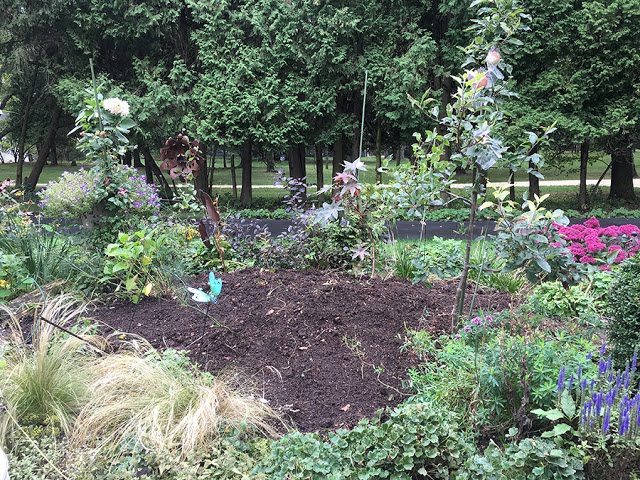
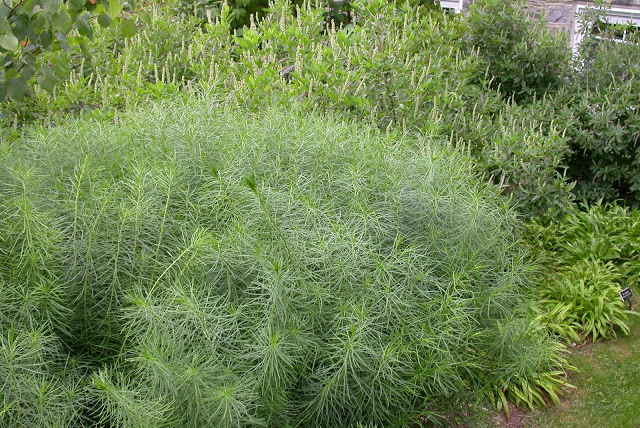
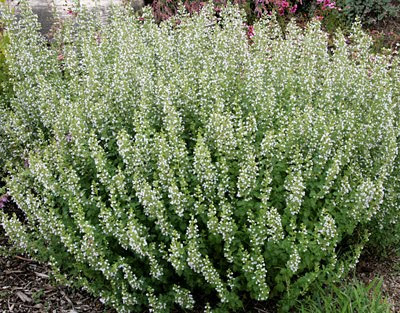
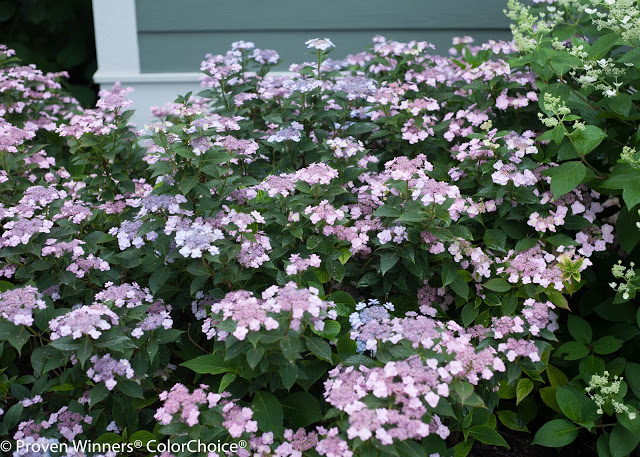

8 Responses
We have Tuff Stuff and I'm surprised at how small it is. You might want to google Tiny Tuff Stuff and read into what's written about it on garden forums. It sounds like it's about the size of a mini-hosta. TINY. I'm not sure where that "Proven Winners" photo is from, but it looks more like the Tuff Stuff hydrangea than the actual images of "Tiny Tuff Stuff" I've seen online.
I have grown Montrose White Calamintha here in Ohio for 5 or 6 years, starts to bloom at the end of June and then covered non-stop with small white flowers till frost. It is covered with bees and other pollinators. Sun loving, easier to grow, looks like “Baby’s Breath” only that does not grow for me while Montrose White keeps producing.
I love my nepetas they are super hardy in my garden but none of them are white so I may have to try this one.
We share two out of three! I love Amsonia, and I have several plants growing in both sun and part shade. I also have some Calamintha, though it has not been as vigorous as I expected.
We live in southern California in the mountains above San Juan Capistrano. Our climate is very similar to Provence, France, sans Le Mistral. Unless you have an army of gardeners, steady reliable perennials are the only way to go. We have over 2 acres of landscaping and I am the primary gardener.
When we bought our home, the builder, in typical California fashion, had scraped every inch of brush and topsoil away. We had two acres of flat DG and sand. There were a few concrete drainage swales but that was about it.
Our backbone was the trees. We brought in dozens of California native oak trees (Q. Englemanni and Q. Lobata) and a few Louisiana Live Oaks (Q. Virginiana) because they grow quickly and seem to do well no matter what. We also used Italian Cypress and Spartan Junipers for "spikey" contrast. The mid range bushes are Ceanothus, several varieties of Cistus (Rockrose), Rosemary in dark blue and medium blue, amd Viburnum "Spingtime Bouquet" for fragrance and a nice display of white. On the northwest side of the house which gets the most shade I have Leatherleaf fern, French Lilacs, violets and Oakleaf Hydrangea.
Our soil is very alkaline so we are constantly topping off with GroMulch and Miraclegrow for Acid loving plants.
Believe it or not, I only spend an average of 1/2 hour per day in the garden. In the winter, a little less. I do use bulbs and some potted plants for spots of color but no beds of pansies or petunias for me! Too much work.
Smiles from Charlotte
As for choosing new plants, I have ordered a lot of unusual things to add this year but generally I am sticking to tried and true if I am buying multiples and want to have a swath of something. So more Geraniums, ferns, Trilliums which have all done well for me. Also am adding a couple more species Peonies and two unusual Witch hazels (one is a dwarf and the other has variegated leaves). Both of those plants have also done well in my garden. Your plan sounds good and should look great.
I've not seen the Amsonia around here. I'll have to keep my eye out for it – love the texture and fall colour. And I love anything blue. I'm sure it will thrive here in SW Ontario if it works in your Wisconsin garden.
I have heard mixed reviews of Montrose White. So if you don't have the plants already or on order, I would consider Calamintha nepeta ssp. nepeta. Olbrich Gardens is using it and I added about 8 plants of it over the last three years. No self seeding, bees love it and looks great for months. A bit late to come up but so is Amsonia.